
Fundamentals of Carbonate Sequence Stratigraphy
Charles Kerans
Scott W. Tinker
Bureau of Economic Geology
| Design Objectives |
| Glossary |
| Credits |
| Back |
| Top |
| Exit |
 |
 |
 |
|
Understanding carbonate rocks: accomodation, depositional environments, and facies. |
|
The
single most important stratigraphic variable that controls the
resultant rock record in a shallow marine setting is depositional
topography. Simply put, the more varied the depositional topography
the more complex the resultant lithofacies, and the more difficult
it will be to interpret stratigraphy between wells. When building
any scale of stratigraphic model, it is critical to unravel the
depositional tapestry. Sesimic images, with the obvious caveats discussed in the prior section, can be useful for interpretation of depositional geometry. Borehole image logs can be quite valuable in terms of determining bedding dip at the borehole scale, which can be a good proxy to depositional topography. Biostratigraphy, chemostratigraphy and magnetostratigraphy can each provide time-significant information that leads to improved sequence stratigraphic interpretation, from which depositional topography is inferred. Cores and logs, and the interpretation of facies from these data, warrants further discussion. |
|
Topography
and Accomodation
|
||
|
Depositional
topography represents a snapshot in time. Changes in topography
through time are represented by changes in facies though time,
and are a record of the long-term accomodation history of a system.
In this sense, the available space is the 3-D volume bounded by
the water-sediment interface below, and base-level above. |
|
In
shallow-water carbonate systems, sea-level is a reasonable proxy
for base-level. In some instances storm wave base can supplant
sea level as the upper limit of sediment accumulation, but in
the big picture, the two critical surfaces that define accommodation
variation are the water-sediment interface and air-water interface
(sea level). There is a systematic relationship between accommodation,
systems tracts, and stratigraphic styles. In general, the transgressive
systems tract is associated with higher accommodation during base-level
rise and the highstand systems tract is associated with low accommodation
settings during base-level fall. Therefore, interpreting the
position of the dataset within a depositional sequence can afford
substantial predictive information concerning stratigraphic style
and correlation methodology.
In contrast, periods of low accommodation (HST) are characterized by:
|
Lithofacies
data are critical for stratigraphic interpretation, construction
of depositional models, petrophysical analysis and prediction,
and 3-D geologic modeling. In order to quantify and use lithofacies
data in 3-D modeling, the dominant set of lithofacies (defined
based on some combination of lithology, texture, grain composition,
and depositional environment) can be given an ordinal numeric
code. This can either be sequential in terms of the ideal stratigraphic
succession, or sequential in terms of petrophysical quality (e.g.
from lowest to highest porosity and/or permeability). Fortunately,
in carbonate rocks that have not been extensively altered by diagenesis,
reservoir quality often mimics stratigraphic succession (e.g.,
a low-energy, subtidal carbonate mudstone at the base of a cycle
has the poorest reservoir quality, and a high-energy, subtidal
ooid grainstone at the top of a cycle has the best reservoir quality),
so the petrophysical succession can be similar to the depositional
succession. Numeric facies coding facilitates statistical analysis
and lithofacies prediction in wells without core control, which
is critical in all reservoirs that have limited core control (most
reservoirs). |
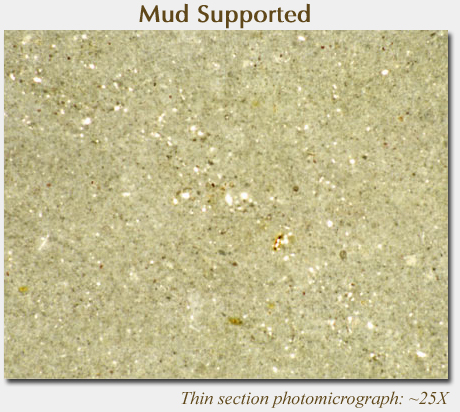 |
|
A
thin section photomicrograph example of mud supported carbonate
rock.
|
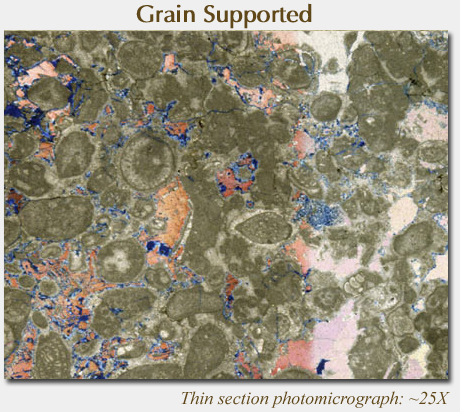 |
| Grain-supported fabrics from the Permian, including fusulinids and algae, are shown in this thin section photomicrograph. Calcite is stained pink; porosity is blue. |
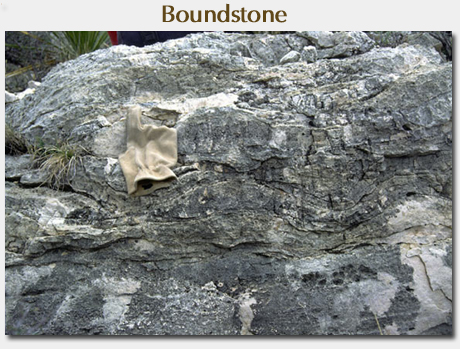 |
| This outcrop reveals mound topography in a tidal-flat environment of algal boundstones (invisible geologist glove for scale). |
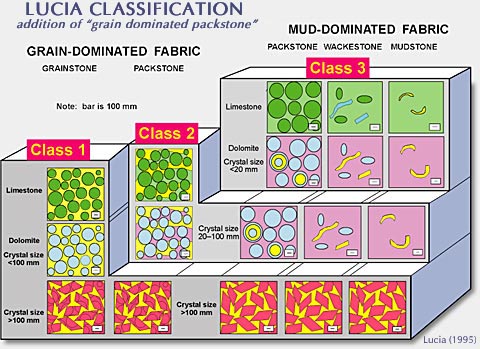 |
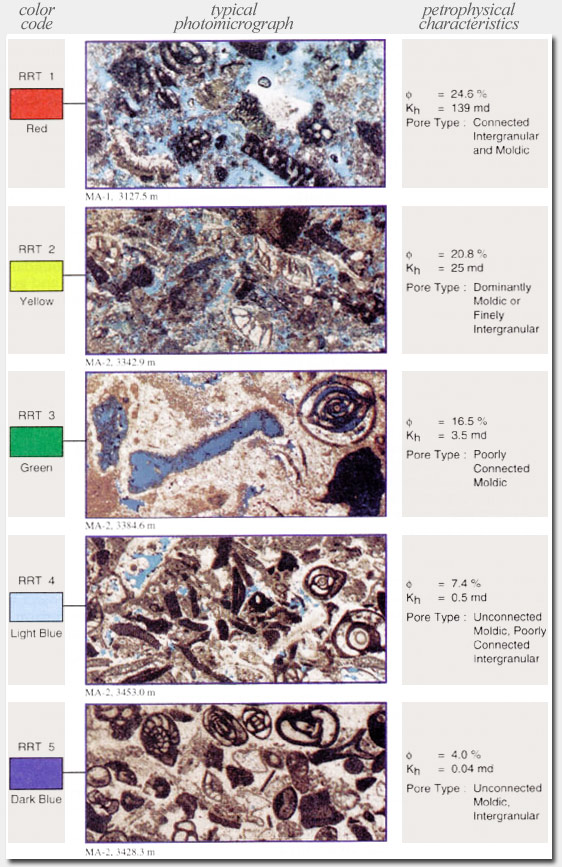 |
|
Grötsch
and Mercadier (1970)
|
|
Permeability
in carbonate systems is constrained by the combination of lithology,
porosity, pore type, cementation, and degree of dolomitization.
The Lucia porosity/permeability classification system extends the
Dunham system by including grain-dominated packstone, a texture
class between grainstones and packstones, and is important in understanding
petrophysical properties. A series of photographs show ranges of
porosity and permeability that all fall within a single Lucia class,
but are of different rock types.
|
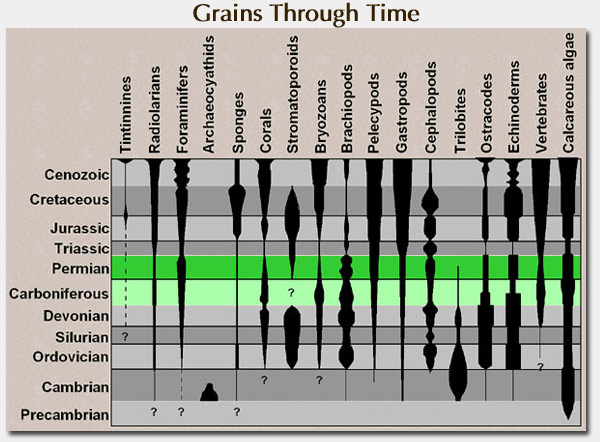 |
|
after
Winkinson (1982)
|
| Changes in grain components through time are an important part of facies identification. Most are predictable long term changes; others indicate episodic or catastrophic extinction events. Grain component changes are primarily the combined result of eustacy, plate tectonics, climate changes driven by earth processes, and extraterrestrial causes. |
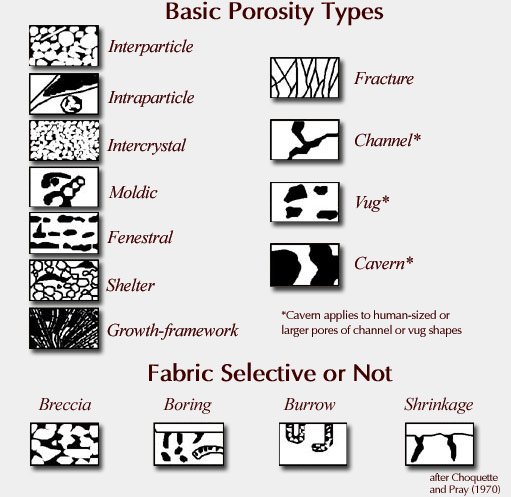 |
| Pore type is also an important component of facies identification. The Choquette and Pray system (Fig. 8) classifies a variety of basic pore types. Those in the left column are useful for stratigraphic analysis, while those in the right column impact fluid flow in rock systems, and are useful for both exploration and production problems. |
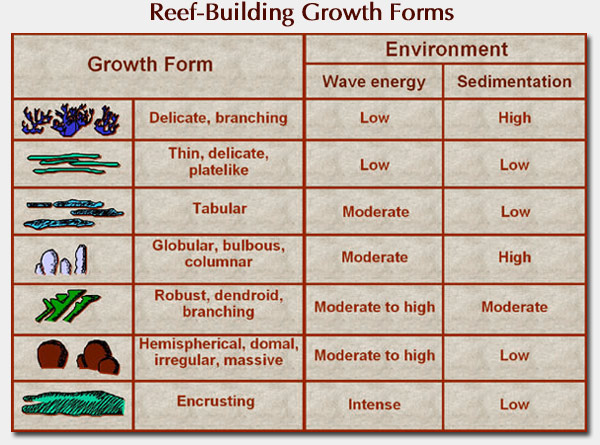 |
|
after
James (1983)
|
| Faunal growth forms are an important key in understanding certain reef depositional environments. Different growth forms indicate varying levels of wave energy and sedimentation, and are therefore indicators of accommodation. |